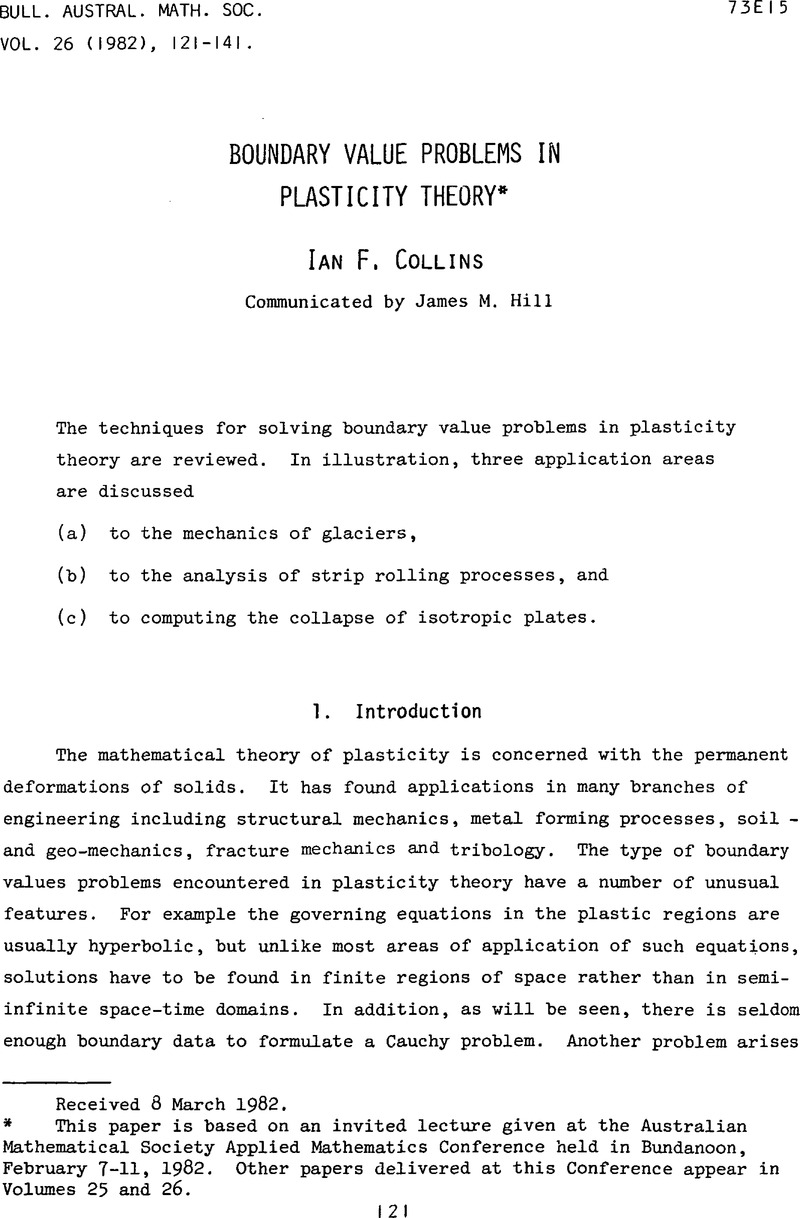No CrossRef data available.
Article contents
Boundary value problems in plasticity theory*
Published online by Cambridge University Press: 17 April 2009
Abstract
An abstract is not available for this content so a preview has been provided. As you have access to this content, a full PDF is available via the ‘Save PDF’ action button.

- Type
- Australian Mathematical Society Applied Mathematics Conference
- Information
- Copyright
- Copyright © Australian Mathematical Society 1982
References
[1]Collins, I.F., “The algebraic-geometry of slip line fields with applications to boundary value problems”, Proc. Roy. Soc. London Ser. A 303 (1968), 317–338.Google Scholar
[2]Collins, I.F., “On an analogy between plane strain and plate bending solutions in rigid/perfect plasticity theory”, Intern. J. Solids and Structures 7 (1971), 1057–1073.Google Scholar
[3]Collins, I.F., “On the theory of rigid/perfectly plastic plates under uniformly distributed loads”, Acta Mech. 18 (1973), 223–254.CrossRefGoogle Scholar
[4]Collins, I.F., “boundary value problems in plane strain plasticity”, Mechanics of solids – The Rodney Hill 60th Anniversary Volume, 135–184 (Pergamon, London, New York, 1981).Google Scholar
[5]Dewhurst, P. and Collins, I.F., “A matrix technique for constructing slip-line field solutions to a class of plane strain plasticity problems”, Intern. J. Numer. Methods Engrg. 7 (1973), 357–378.CrossRefGoogle Scholar
[6]Ewing, D.J.F., “A series-method for constructing plastic slipline fields”, J. Mech. Phys. Solids 15 (1967), 105–114.CrossRefGoogle Scholar
[7]Fox, E.N., “Limit analysis for plates: a simple loading problem involving a complex exact solution”, Philos. Trans. Roy. Soc. London Ser. A 272 (1972), 463–492.Google Scholar
[8]Fox, E.N., “Limit analysis for plates: the exact solution for a clamped square plate of isotropic homogeneous material obeying the square yield criterion and loaded by uniform pressure”, Philos. Trans. Roy. Soc. London Ser. A 277 (1974–1975), 121–155.Google Scholar
[9]Garabedian, P.R., Partial differential equations (John Wiley & Sons, New York, London, 1964).Google Scholar
[12]Johnson, W., Sowerby, R. and Haddow, J.B., Plane-strain slipline fields: Theory and bibliography (Edward Arnold, London, 1970. Second edition, to appear).Google Scholar
[13]Massonet, Ch., “Complete solutions describing the limit state of reinforced concrete slabs”, Mag. Conor. Res. 19 (1967), 13–32.CrossRefGoogle Scholar
[14]Nye, J.F., “The flow of glaciers and ice-sheets as a problem in plasticity”, Proc. Roy. Soc. London Ser. A 207 (1951), 554–572.Google Scholar
[15]Paterson, W.S.B., The physics of glaciers, 2nd edition (Pergamon Press, Oxford, 1981).Google Scholar
[16]Schumann, Walter, “On limit analysis of plates”, Quart. Appl. Math. 16 (1958), 61–71.Google Scholar
[17]Wood, R.H., “A partial failure of limit analysis for slabs, and the consequences for future research”, Mag. Concr. Res. 21 (1969), 79–90.CrossRefGoogle Scholar


